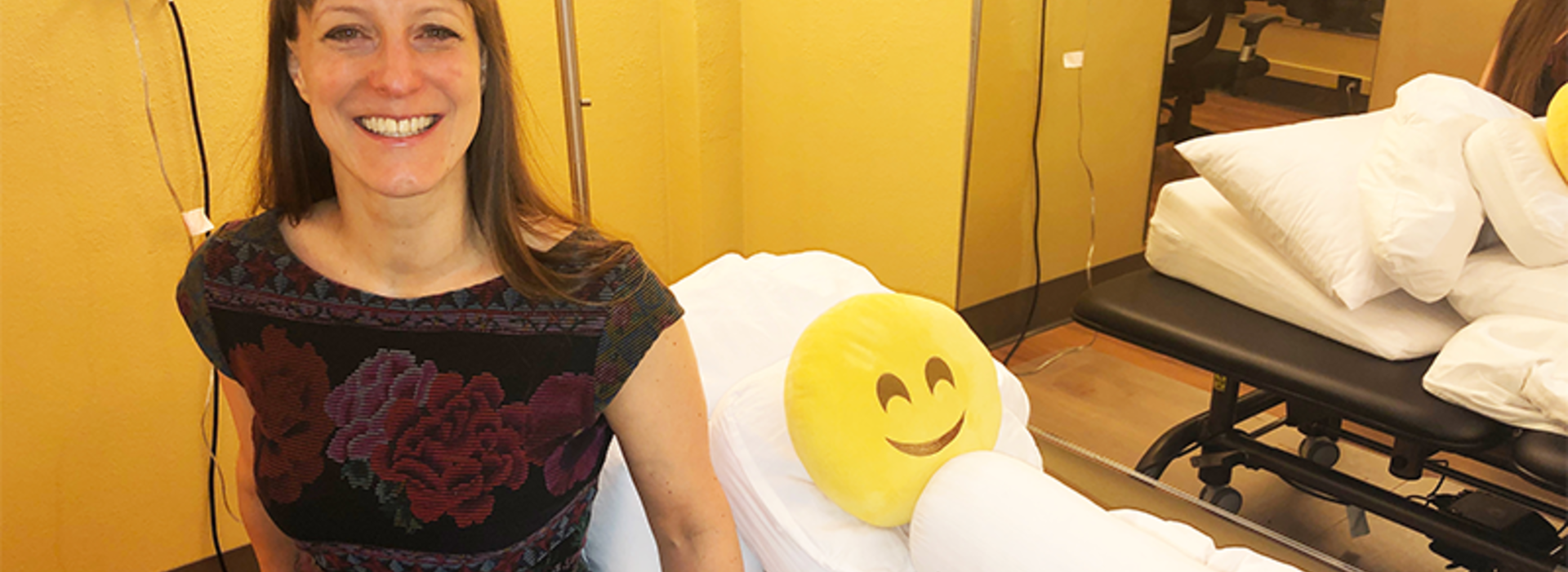
Faculty Spotlight: Ann Van de Winckel
Ann Van de Winckel, PhD, MSPT, PT, has always held a passion for helping people. She first explored this route through physical therapy, knowing from the start that performing invasive procedures herself was not an interest of hers. As she followed this path, she found herself drawn to conventional as well as complementary and integrative approaches that hold a holistic view of healing body and mind.
“My long-term goal is to integrate complementary and integrative approaches with conventional approaches to help people recover and heal. The main thread of my research is body awareness. Body awareness is the ability to know where your body is positioned or moving in space. It also pertains to the ability of how parts of your body are positioned or moving in relation to other parts of the body or in relation to objects in the space,” says Dr. Van de Winckel, explaining the purpose of her current research in her Brain Body Mind lab.
Over the past 20 years, Dr. Van de Winckel has worked on improving upper limb recovery after stroke, by investigating the mechanisms of cognitive multisensory rehabilitation, a therapy that originated in Italy. This therapy specifically focuses on body awareness and quality of movement to enhance motor recovery after stroke.
One way of investigating how a therapy is effective at helping motor recovery post-stroke is to look at what happens in the brain during certain exercises given in this therapy. Some of these exercises entail recognizing different shapes from each other. Because Dr. Van de Winckel wanted to know how people differentiate shapes from each other, she designed a task in the MRI scanner in which an MRI compatible robot was moving the finger to make shapes in the air. Her control condition was differentiating music fragments. The result of what happens in the brain when people are discriminating shapes is brain activation in the shape of a “smiley face”, seen through an MRI scan.

(Van de Winckel, A.; Sunaert, S.; Wenderoth, N.; Peeters, R.; Van Hecke, P.; Feys, H.; Horemans, E.; Marchal, G.; Swinnen, S. P.; Perfetti, C.; De Weerdt, W., Passive somatosensory discrimination tasks in healthy volunteers: Differential networks involved in familiar versus unfamiliar shape and length discrimination. Neuroimage 2005, 26 (2), 441-453.)
Dr. Van de Winckel completes this research with the use of her two MRI compatible robots. "I designed them in Belgium, where a company custom-built them for me. I then flew them over to the US. There are only two like this in the world,” she explains.
Recently, she completed research on the effects on the brain and on motor recovery in participants one to seven years post-stroke in which they were given cognitive multisensory rehabilitation for six weeks, three times a week for 45 minutes per session. On average, participants were able to recover about 30 percent of their motor function and they reported that this improvement had a positive effect on their daily life.
Reflecting on the start of her research, she explained why she decided to come to the University of Minnesota after completing her bachelors, masters, PhD and six years of postdoc at the University of Leuven in Belgium.
“We have a very big center of spirituality and healing here at the University of Minnesota (Earl E. Bakken Center for Spirituality & Healing), so they are very open to ideas on integrating body and mind,” she says. Dr. Van de Winckel also goes on to say how the University of Minnesota has the largest MRI center in the US (Center for Magnetic Resonance Research), which makes it an ideal place to be when conducting brain imaging research.
Her passion for healing, research, teaching and mentoring is palpable. Currently, Dr. Van de Winckel has submitted a grant to investigate brain mechanisms in Qigong for people with chronic low back pain in collaboration with the Earl E. Bakken Center for Spirituality & Healing.
Other research on body awareness and body image is ongoing. Her keen eye for research rounds out her work here. “I love discovery through research; finding new ways to help people recover and heal more efficiently and have a greater quality of life; guiding people towards learning and self-development. I love my work and everything I do,” she says.